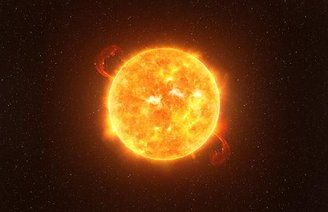If there is no oxygen in space, how does the Sun catch fire? Science responds!

The Sun is considered the most important star in our system, after all, it is this massive cosmic object that lights up the days on Earth and makes life as we know it possible. It is a gigantic ball of fire that burns constantly at almost unimaginable temperatures; it would be impossible for a human to survive if they were too close to the star.
Here on Earth, if we use fire to burn something, the element uses its own oxygen in the area to strengthen the flame. In other words, in a completely sealed and vacuum environment, it would not be possible to start the fire burning process. This is exactly why many people wonder… After all, how can the Sun burn so intensely if there is no oxygen in space?
“The Sun, like other stars, is a sphere of gas. In terms of the number of atoms, it is composed of 91.0% hydrogen and 8.9% helium. In terms of mass, the Sun is approximately 70.6% hydrogen and 27.4% helium. The enormous mass of the Sun is held together by gravitational attraction, producing immense pressure and temperature at its core”, the US National Aeronautics and Space Administration (NASA) describes in an official publication.
First, it is necessary to explain that oxygen exists in some regions of space, however, it is a little different. Molecular oxygen can be found in some places, such as the Rho Ophiuchi cosmic cloud and the Orion Nebula, however, only in its molecular format. But it is not because of oxygen that the star in the Solar system constantly produces high temperatures.
To explain a little more about how the Sun 'burns' without oxygen in space, TecMundo gathered information from experts, astronomers and other scientists in the field. Check out!
Without oxygen: Fire in the Sun
Despite the existence of molecular oxygen in space, it is important to highlight that this is not what makes the Sun burn continuously — in fact, this type of oxygen was not found in abundance. The truth is that fire, as humanity knows it, is possibly only available on Earth. Our planet is the only place we know categorically that fire can be produced.
The reality is that the Sun does not burn the same fire that we find on Earth; it is a powerful nuclear reaction that releases a gigantic amount of energy. The Sun is like a huge ball of gas, made up of 91% hydrogen and 8.9% helium in terms of the number of atoms. In relation to mass, it represents approximately 70.6% hydrogen and 27.4% helium.
“At the core, the temperature is approximately 27 million degrees Fahrenheit (15 million degrees Celsius), which is sufficient to sustain thermonuclear fusion. This is a process in which atoms combine to form larger atoms and, in the process, release impressive amounts of energy. Specifically, in the Sun's core, hydrogen atoms fuse to form helium. The energy produced in the core powers the Sun and generates all the heat and light the Sun emits,” NASA adds.
 To burn fire on Earth, at least 16% atmospheric oxygen is required; Scientists have already proven that our atmosphere contains 21% oxygen. But on the Sun, the 'burning' process is slightly different. Source: Getty Images
To burn fire on Earth, at least 16% atmospheric oxygen is required; Scientists have already proven that our atmosphere contains 21% oxygen. But on the Sun, the 'burning' process is slightly different. Source: Getty Images
For nuclear fusion to occur perfectly, the particles present in the Sun collide with each other quickly, and these collisions are so strong that they remain as a single large mass.. Nuclear fusion activity is so intense that it releases unimaginable amounts of energy, resulting in high temperatures in the core and surface of the Solar System's main star.
Although heat is spread throughout the Sun, the core is the hottest region and, from there, temperatures spread to the edges. In addition to being responsible for the high temperature, This process is also what makes the star shine and makes it possible to illuminate the regions around it, as happens during the day on Earth.
The Sun's radiation is transported through the radioactive zone and takes up to 170,000 years to leave the core and reach the top of the convective zone on the solar surface, where large bubbles of hot plasma occur.
According to NASA, the star's surface reaches temperatures of 5,500 degrees Celsius. Despite already representing high temperatures, the heat in the core is even more intense — to the point of causing highly rigid substances, such as graphite and diamond, to boil.
I.e, the Sun does not have any type of fire as we know it on our planet, as the high amounts of energy and high temperatures come from the nuclear reaction at the center of the star. The heat that arrives on Earth is caused by solar radiation emitted by the Sun when interacting with particles in the Earth's atmosphere.
Did you like the content? So don't forget to share the article on your social networks, after all, your friends may also like to know about this curiosity about our star king!





